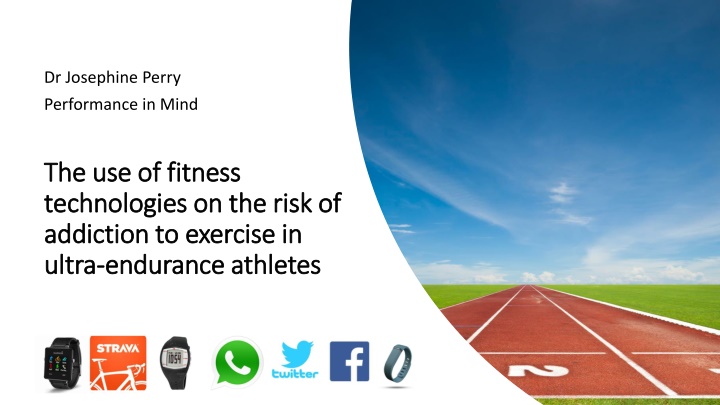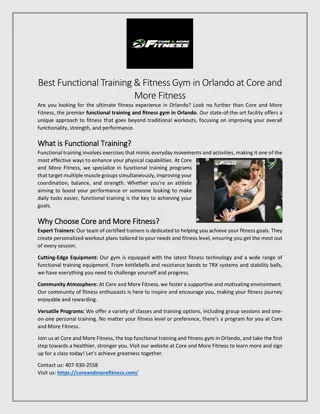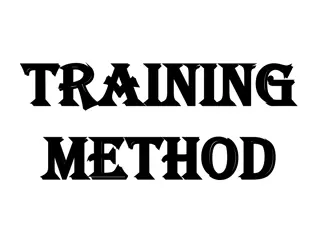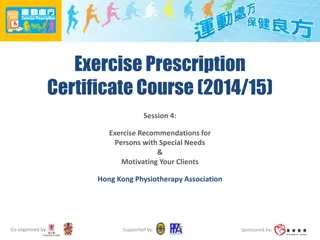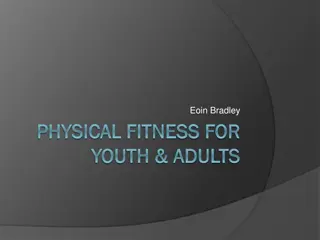Fitness Technology Use and Risk of Exercise Addiction Among Ultra-Endurance Athletes
Research investigates the impact of fitness technologies on exercise addiction among ultra-endurance athletes. High technology usage correlates with an increased risk of addiction. Factors influencing exercise addiction include personality traits and sports involvement. Findings reveal 44.7% of athletes at risk. The study aims to understand the relationship between technology use and addiction vulnerability in a population of 255 ultra-endurance athletes.
Download Presentation

Please find below an Image/Link to download the presentation.
The content on the website is provided AS IS for your information and personal use only. It may not be sold, licensed, or shared on other websites without obtaining consent from the author.If you encounter any issues during the download, it is possible that the publisher has removed the file from their server.
You are allowed to download the files provided on this website for personal or commercial use, subject to the condition that they are used lawfully. All files are the property of their respective owners.
The content on the website is provided AS IS for your information and personal use only. It may not be sold, licensed, or shared on other websites without obtaining consent from the author.
E N D
Presentation Transcript
Dr Josephine Perry Performance in Mind The use of fitness The use of fitness technologies on the risk of technologies on the risk of addiction to exercise in addiction to exercise in ultra ultra- -endurance athletes endurance athletes
There is a UK health crisis which could be partially addressed through increased physical activity. Technologies are being created and utilised to help the inactive become more physically active. Early research shows they are often effective and creating positive behaviour change: 33% less time spent sedentary & significant increase in energy expenditure (1) Step and calorie burning targets through trackers encouraged young people to do more physical activity (2) Inspiration However .if fitness technologies are making exercise stickier for those starting out on their exercise journey what impact are they having on those already keenly exercising
Risk of addiction: Prevalence rates: Salience Conflicts Mood enhancement Increasing dosage Withdrawal Relapse Public 2.5% (3) Body builders - 26.7% (4) Ultra runners 27% (5) Ironman 30% (6) Triathletes - 30.4% (7) Elite athletes 34% (8) Exercise addiction Identified risk factors Endurance sports Specific personality traits (Narcissism, Extroversion, Conscientiousness, Perfectionism) Inconsistent self-esteem Age Length of sport
1. Does high use of fitness technology increase the risk of exercise addiction? 2. How are those athletes at high risk of exercise addiction impacted by their use of fitness technologies? Study aims
255 ultra endurance athletes (swimmers over 5k, triathletes competing at half ironman distance or over, runners racing at marathon distance or over, cyclists 100k regularly or over) Sporting information (training load, sports competed in, length of time in sport) Fitness technology use (GPS watch, online tracker, online diary, Twitter, Facebook, Whatsapp, blogging, podcasts, online forums. 5 point likert scale, scoring 30 or over indicating very high use) Exercise Addiction Inventory (3) (6 questions, 5 point likert scale, scoring 24 or above suggests risk of addiction) All completed online in May/June 2017. Analysed through a linear regression. Methodology: Quantitative study
44.7% of ultra endurance athletes within the study were shown to be at risk of exercise addiction. Quantitative findings High use of fitness technology does increase the risk of exercise addiction: There was a positive correlation between the level of use of fitness technology (M=17.00, SD=6.25) and risk of exercise addition (M=22.66, SD=3.70), r=.21, p=.001. 4.6% of the variance in risk of exercise addiction can be explained by the level of use of fitness technology (F 1, 254) = 12.17, p=.001
The quantitative study was used to identify potential interviewees who would need to have very high technology use (26), be at risk of exercise addiction (114) and be open to being interviewed (69). 12 athletes fulfilled all three criteria. 6 agreed to participate in interview: 4 triathletes, 1 runner, 1 cyclist. Aged between 27 and 70. Between 1 & 13 years in sport. Methodology: Qualitative study Phone interviews (lasting on average 44 minutes) Following interview guide Analysed through IPA
1. Athletes addicted to their sport rather than exercise Qualitative findings 2. No unified way athletes are choosing how to use technology 3. Online communities helping override loneliness 4. Technologies sticky to the point of harm 5. Technologies increasing pressure on athletes
Athletes addicted to their specific sport not exercise I don't do the training because I enjoy training. I train to perform in the race, definitely. So I guess what keeps me competing is that feeling of racing and crossing the finish line really... Certainly, I don't train to train, I'm not one of those. But I do like it- don't get me wrong, I don't go out there every day and go, Oh my God, I hate this, but I can't see that I would do it to the extent that I do it if I didn't have the goal and a race to train for.
The GPS watch, I've just got so used to it that I think it would take a long period for me to adjust not just to training but general life without it I suppose I probably could do without it, but I would find training particularly to be slightly more troublesome without any measure of GPS tracking. No unified way athletes are choosing how to use technology It's just interest about races. A lot of them post up little tidbits about races that are always quite interesting to read, whether it's just curiosity or because it's a race I'm thinking of maybe doing in the future. For the bulk of my workouts, I spend it simply trying to chase the numbers on the screen. Ultimately, my sense of satisfaction on a run or ride is not from how I felt, but how I ranked on Strava.
I would say thats the main thing Ive got out of it that feeling of being connected more via social media Triathlon and running can be quite a solitary sport, and you don t have the motivations of fellow team mates to encourage you to train I guess Strava is filling that void to a certain extent. Online communities helping override loneliness I d use [Facebook] a few times a day and it s following trends, following posts, just being nosy looking for information and seeing what s going on I started looking at posts and things from professional athletes, just nosiness I guess and habit maybe. I guess it makes me feel more like part of the sport.
I think that this can tap into the insecurities of athletes and constantly reminds them of how much better they could be here is a danger of losing the focus of one s own training and specific programme as you try to match what 20 other people (who are virtual strangers) are doing. Technologies sticky to the point of harm I was so determined I was going to hit 100k that I went and I ran when I probably shouldn't have run and I really got close to being very, very sick in the lead up to that race.
I went out for a longish ride after work (50 miles) and switched the Garmin on before I set off. The battery was dead so could not record my ride. Immediately, I was disappointed that it would not be recorded and uploaded onto Strava for all to see! But then as I pedalled along, it was refreshing not to have my average speed flashing at me, urging me to go faster! I knew that neither myself or anyone else would see my split breakdown & everything suddenly felt less pressured. Technologies helpful but increase pressure This weekend, I went for a 10 mile run. It was only meant to be steady I averaged 4:30/km, it felt good, the sun shone, I ran along the Brecon canal, the birds were tweeting, and I finished with a cappuccino at a country pub. It was perfect. Then I got home, uploaded the run to Strava, and immediately saw that a couple of my friends and people that I follow had run a couple of kms further than me, and my brother had run at a higher pace than me. Immediately, it took the gloss off my run, and I felt like I should have run faster and further than the 10 miles. My efforts suddenly felt inadequate.
1. Barwais, F. A., & Cuddihy, T. F. (2015). Empowering Sedentary Adults to Reduce Sedentary Behavior and Increase Physical Activity Levels and Energy Expenditure: A Pilot Study. International Journal of Environmental Research and Public Health 12, 414-427. 2. Goodyear, V. A., Kerner, C. & Quennerstedt, M. (2017). Young people s uses of wearable healthy lifestyle technologies; surveillance, self-surveillance and resistance. Sport, Education and Society (in print). 3. Terry, A., Szabo, A., & Griffiths, M. (2004). The exercise addiction inventory: A new brief screening tool. Addiction research and theory, 12(5), 489-499. 4. Salazar, J. A. A., Castro, S. G., Zambrano, C. R., & Buitrago, S. V. (2012). Levels of body exercise addiction in bodybuilders. Revista Iberoamericana de Psicologia del Ejercicio y el Deporte References 5. Scheer, V. & Hahn, S. (2014). Conference Paper: Are ultramarathon runners exercise addicts? German Association of Sports Medicine; 45th Sports Medicine Congress Sept 2014. 6. Magee, C. A., Buchanan, I., & Barrie, L. (2016). Profiles of exercise dependence symptoms in Ironman participants. Psychology of Sport and Exercise, 24. 48-55. 7. Blaydon, M. J., & Lindner, K. J. (2002). Eating disorders and exercise dependence in triathletes. Eating Disorders, 10(1), 49-60. 8. Mc Namara, J. & McCabe, M. P. (2012) Striving for success or addiction? Exercise dependence among elite Australian athletes. Journal of Sports Sciences, 30(8), 755- 766.
